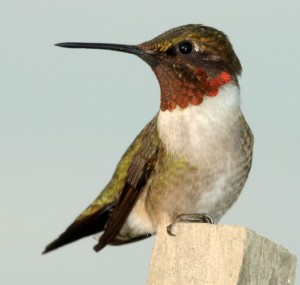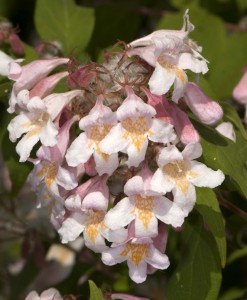Life is for the Birds
Posted in Gardening Tips on November 27 2012, by Sonia Uyterhoeven
Sonia Uyterehoven is the NYBG‘s Gardener for Public Education.
 I read somewhere that a hummingbird’s wings beat between 70 and 80 times a second, and can accelerate up to 200 beats per second during courtship. They can fly at an average speed of 25 to 30 miles per hour, but can dive at 60 miles per hour. With all this hyperactivity, these birds need sugary nectar to support their high-energy bursts.
I read somewhere that a hummingbird’s wings beat between 70 and 80 times a second, and can accelerate up to 200 beats per second during courtship. They can fly at an average speed of 25 to 30 miles per hour, but can dive at 60 miles per hour. With all this hyperactivity, these birds need sugary nectar to support their high-energy bursts.
Fortunately for them, some flower nectar has about two times as much sugar as the average soft drink. The blooms these birds favor tend to be bright red, pink, and orange–flowers in the shape of long tubes that are adapted to the hummingbird’s narrow bill. However, like other avian species they have a poor sense of smell, so the colorful flowers they pollinate do not have strong fragrances.
Because of their tiny little feet, hummingbirds like to rest on trees and shrubs that have a fine branch structure, such as birch (Betula), redbuds (Cercis), and spicebush (Lindera). When it rains, they look for trees with large leaves–such as the redbud or horse chestnut (Aesculus)–to take shelter. These are just two of the considerations to take if looking to inform your own pollinator garden.

In order to attract hummingbirds, it is best to plant annuals and perennials in large groups to provide them with ample nectar. Some hummingbird-friendly annuals that were popular in the NYBG this year include the ornamental Salvia ‘Wendy’s Wish’, pineapple sage (Salvia elegans), and the cigar plant (Cuphea micropetala). The cigar plant grows to about three feet tall with a two-foot spread, while the salvias easily reach three to five feet and over two feet wide. In our Garden, these annuals flower throughout the entire summer. The salvias in particular benefit from deadheading to keep them flowering all season, while the cigar plant is fairly self-sufficient and doesn’t require deadheading. All three annuals mentioned are deer resistant.
Some nice shrubs to have in your garden to attract hummingbirds are lilacs (Syringa), beautybush (Kolkwitzia), and abelia (Abelia grandiflora). Some vines and perennials that they also enjoy are the trumpet vine (Campsis radicans), cardinal flower (Lobelia cardinalis), and the red bee balm ‘Jacob Kline’ (Monarda didyma ‘Jacob Kline’).
The hummingbird’s diet consists of flower nectar and small insects, which means you should use harmful pesticides sparingly. Otherwise, you will not only be ridding your garden of bugs, but the wildlife you are interested in attracting as well. Furthermore, you should always remember that hummingbirds (not to mention other bird species) cannot live on flowers alone–you should also supply a clean water source where they can drink and bathe.
Header image courtesy of Wikimedia Commons.

